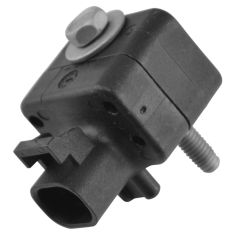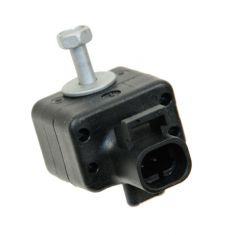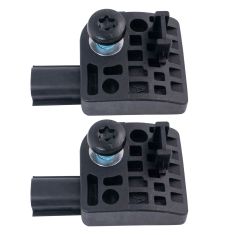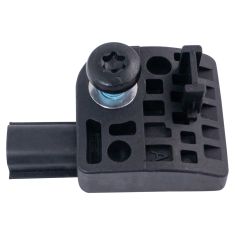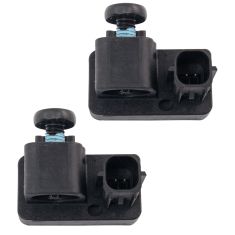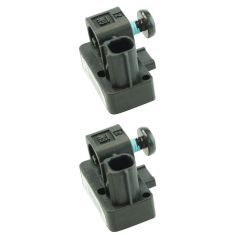Airbag Impact Sensors
-
-
- Air Deflectors & Valance Panels
- Battery Trays & Related
- Body Panels
- Bumpers & Related - Front & Rear
- Convertible Tops, Soft Tops, & Parts
- Decal & Stripe Kits
- Emblems & Nameplates
- Engine Compartment Trim
- Frame Parts & Bushings
- Fuel Door Parts
- Fuel Tank Filler Neck
- Grille
- Header Panel
- Hood & Hatch Lift Supports
- Hood Latch & Catch Brackets
- Hood Release Cable
- Jack Pads
- Radiator Supports
- Rust Repair Panels
- Splash Shields & Fender Liners
- Tailgate Cables
- Tailgate Hinges & Related
- Weatherstripping
-
- Car Covers
- Exterior Lighting
- Exterior Parts & Accessories
- Exterior Safety & Security
- Exterior Storage
- Fender Flares
- License Plate Brackets & Frames
- Mud Flaps & Splash Guards
- Nerf Bars, Side Steps, Running Boards
- Radio Antenna
- Rain Deflectors
- Roll Bars, Light Bars, & Related
- Roof Rack
- Skid Plates
- Spare Tire Carriers & Related
- Spare Tire Covers
- Tire Care
- Tonneau Covers
- Tow Hooks & D-Shackles
- Towing Accessories
- Trailer Hitch & Components
-
- Accelerator Pedal Pad
- Auto Carpet
- Brake Pedal Pad
- Clutch Pedal Pad
- Console Parts
- Dash Pad Cover
- Dash Vents
- Floor Mats & Liners
- Horns & Horn Parts
- Interior Parts & Accessories
- Mirror - Interior Rear View
- Seat Cover and Sets
- Seat Heater Kits
- Seat Parts and Accessories
- Sun Visors & Related
- Trunk & Cargo Parts
-
- Accelerator Pedals & Sensors
- Alarms, Control Modules, & Remote Start
- Cruise Control Switch & Lever
- Electrical Parts
- Hazard Switch
- Ignition Key Lock Cylinder
- Ignition Switch
- Keyless Entry Remote & Related
- Neutral Safety Switch
- Parking Assist Cameras & Monitors
- Power Mirror Switch
- Power Seat Switches
- Power Window Switch
- Radio, Navigation, Entertainment
- Reverse Light Switch
- Trunk Release & Lock Solenoids
- Turn Signal Switches and Levers
- Windshield Wiper Switch
-
- Idler Arm
- Pitman Arm
- Power Steering Hoses
- Power Steering Oil Cooler
- Power Steering Pressure Sensor
- Power Steering Pump
- Power Steering Pump Cooling Fan
- Power Steering Pump Pulley
- Power Steering Pump Reservoir
- Steering Dampers
- Steering Knuckles and Spindles
- Steering Rack and Gear Boxes
- Steering Shafts & Couplers
- Steering Wheels & Column Parts
- Tie Rods & Adjusting Sleeves
-
-
-
-
11
2
10
10
-
Notify When Available
Replaces 2009 Chevrolet GMC Cadillac Front Radiator Support Mounted Impact Airbag Sensor Dorman OE Solutions 590-222
Brand: Dorman OE Solutions - 590-222$155.45Save 29%List $218.95 Save $63.50Brand: Dorman OE Solutions - 590-222$155.45Save 29%List $218.95 Save $63.50 -
Notify When Available
Replaces Chevrolet GMC Impact Airbag Sensor Dorman OE Solutions 590-205
Brand: Dorman OE Solutions - 590-205$175.45Save 29%List $247.95 Save $72.50Brand: Dorman OE Solutions - 590-205$175.45Save 29%List $247.95 Save $72.50 -
Notify When Available
Replaces 2009 Chevrolet GMC Cadillac Front Radiator Support Mounted Impact Airbag Sensor 2 Piece Set Dorman OE Solutions 1ABMK00227
Brand: Dorman OE Solutions - 1ABMK00227$279.95Save 33%List $415.95 Save $136.00Brand: Dorman OE Solutions - 1ABMK00227$279.95Save 33%List $415.95 Save $136.00 -
Notify When Available
Replaces Chevrolet GMC Cadillac Front Impact Airbag Sensor Dorman OE Solutions 590-283
Brand: Dorman OE Solutions - 590-283$155.45Save 33%List $231.95 Save $76.50Brand: Dorman OE Solutions - 590-283$155.45Save 33%List $231.95 Save $76.50 -
Notify When Available
Replaces Chevrolet GMC Buick Cadillac Impact Airbag Sensor 2 Piece Set Dorman OE Solutions DMZMA00005
Brand: Dorman OE Solutions - DMZMA00005$279.95Save 38%List $451.95 Save $172.00Replaces Chevrolet GMC Buick Cadillac Impact Airbag Sensor 2 Piece Set Dorman OE Solutions DMZMA00005
Brand: Dorman OE Solutions - DMZMA00005$279.95Save 38%List $451.95 Save $172.00 -
Notify When Available
Replaces Chevrolet GMC Buick Cadillac Impact Airbag Sensor Dorman OE Solutions 590-285
Brand: Dorman OE Solutions - 590-285$142.45Save 40%List $236.95 Save $94.50Brand: Dorman OE Solutions - 590-285$142.45Save 40%List $236.95 Save $94.50 -
Notify When Available
Replaces Chevrolet GMC Cadillac Front Impact Airbag Sensor 2 Piece Set Dorman OE Solutions DMZMA00004
Brand: Dorman OE Solutions - DMZMA00004$279.95Save 36%List $435.95 Save $156.00Replaces Chevrolet GMC Cadillac Front Impact Airbag Sensor 2 Piece Set Dorman OE Solutions DMZMA00004
Brand: Dorman OE Solutions - DMZMA00004$279.95Save 36%List $435.95 Save $156.00 -
Notify When Available
Replaces Chevrolet GMC Front Impact Airbag Sensor Dorman OE Solutions 590-225
Brand: Dorman OE Solutions - 590-225$147.45Save 32%List $215.95 Save $68.50Brand: Dorman OE Solutions - 590-225$147.45Save 32%List $215.95 Save $68.50 -
Notify When Available
Replaces Chevrolet GMC Front Impact Airbag Sensor 2 Piece Set Dorman OE Solutions 1ABMK00241
Brand: Dorman OE Solutions - 1ABMK00241Out of Stock
$ 279.95Brand: Dorman OE Solutions - 1ABMK00241Out of Stock
$ 279.95 -
Notify When Available
Replaces Chevrolet GMC Front Impact Airbag Sensor Dorman OE Solutions 590-206
Brand: Dorman OE Solutions - 590-206Out of Stock
$ 164.95Brand: Dorman OE Solutions - 590-206Out of Stock
$ 164.95
loading...
Choose the Make of Your Vehicle
